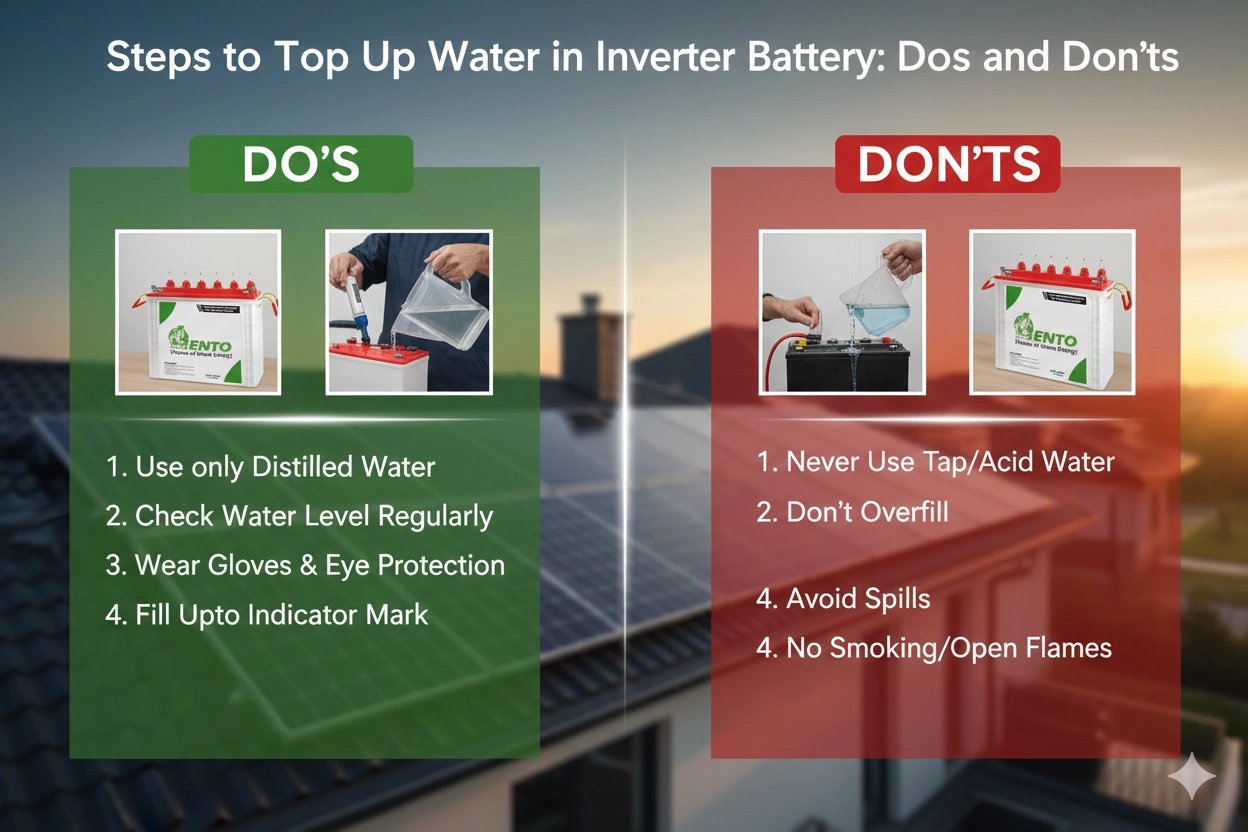
Steps to Top Up Water in Inverter Battery Dos and Don’ts
05 December 2025
Maintaining your inverter battery is essential to ensure long-lasting backup power and optimal performance. One of the key maintenance tasks is topping up distilled water in your battery, especially if you are using tubular batteries supplied by a trusted tubular battery manufacturer. Many home users and businesses often overlook this simple task, which can significantly affect battery life and efficiency.
In this blog, I’ll walk you through the proper steps to top up water in an inverter battery, explain the dos and don’ts, and share practical tips that will help you protect your investment in batteries and inverters.
Why Topping Up Water in an Inverter Battery Is Important
Inverter batteries, particularly lead-acid and tubular batteries, rely on a chemical reaction between the electrolyte and lead plates to store energy. During charging and discharging, water in the electrolyte evaporates. If the water level drops too low:
-
The lead plates may be exposed, causing permanent damage.
-
The battery’s capacity decreases, reducing backup time.
-
Sulphation may occur, shortening the battery lifespan.
By regularly checking and topping up water, you ensure that your battery continues to perform reliably, whether it’s part of a home backup system or a commercial setup sourced from a solar products manufacturer, exporter, or supplier.
Step-by-Step Guide to Topping Up Water in Your Battery
Here’s how you can safely top up water in your inverter battery:
1. Switch Off the Inverter
Before touching the battery, turn off your inverter and unplug it from the mains. This prevents electrical accidents and protects you from potential shocks.
2. Open the Battery Caps
Most tubular and lead-acid batteries have removable caps. Carefully remove them to access the cells. Avoid using sharp tools that may damage the battery casing.
3. Check the Water Level
Look inside each cell. Most batteries have a minimum and maximum level mark. The electrolyte should cover the plates and be below the maximum mark.
4. Use Distilled Water Only
Never use tap water, RO water, or other types of water. Distilled water ensures that no minerals or impurities enter the battery, which could reduce efficiency or cause internal damage.
5. Top Up Slowly
Pour distilled water gradually into each cell until the electrolyte reaches the recommended level. Avoid overfilling, as it can cause electrolyte overflow during charging.
6. Close the Caps Securely
Once the water is topped up, securely close the battery caps. This prevents contamination and keeps the electrolyte at the correct level.
7. Clean the Battery Surface
Wipe off any spilled water or electrolyte from the battery surface to prevent corrosion and rusting.
8. Switch On the Inverter
After completing the top-up, switch on your inverter and check if it’s functioning normally.
Dos When Topping Up Water in an Inverter Battery
Following proper dos ensures battery longevity and safe handling:
-
Do use distilled water only. It maintains the chemical balance inside the battery.
-
Do wear protective gloves and eyewear. Batteries contain acid, which can be harmful.
-
Do check water levels regularly. At least once every two months for tubular batteries.
-
Do top up during the evening or early morning. This prevents rapid evaporation and reduces risk during hot conditions.
-
Do follow manufacturer guidelines. Battery instructions from a tubular battery manufacturer, lithium ion battery manufacturer, or solar inverter manufacturer should always take priority.
Don’ts When Topping Up Water in an Inverter Battery
Avoiding common mistakes protects both you and your battery:
-
Don’t overfill the cells. Overfilling leads to spillage and corrosion.
-
Don’t use tap or RO water. Impurities cause deposits that reduce battery efficiency.
-
Don’t mix battery brands or types. Different batteries may have different electrolyte requirements.
-
Don’t top up when the battery is charging. The chemical reaction can cause acid to splash.
-
Don’t ignore warning signs. Swelling, leakage, or unusual heat indicates a problem that needs professional attention.
Additional Tips for Maintaining Your Inverter Battery
Here are some practical tips to enhance battery performance:
-
Keep your battery clean and dry to prevent corrosion.
-
Regularly check voltage levels using a multimeter.
-
Use high-quality inverters and batteries from a trusted solar products manufacturer, exporter, or supplier.
-
If using a lithium-ion battery, note that water topping is generally not required, but periodic checks of the BMS (Battery Management System) are essential.
-
Ensure your inverter is not overloaded, as heavy loads can reduce battery life.
By following these tips, your inverter and battery system will deliver consistent backup power, whether it’s for a home, office, or industrial setup.
Why Proper Battery Maintenance Matters
Proper maintenance, including topping up water, ensures that your battery:
-
Delivers maximum backup time during power outages.
-
Maintains long-term efficiency and performance.
-
Reduces repair or replacement costs over time.
-
Works efficiently with inverters, online UPS systems, and solar setups.
Investing a few minutes every month in battery maintenance saves money and ensures reliability, whether your system is sourced from a tubular battery manufacturer, solar inverter manufacturer, or online UPS manufacturer.
Final Thoughts
Topping up water in your inverter battery is a simple yet crucial maintenance task. Following the proper steps, dos, and don’ts protects your battery, maximizes backup time, and extends overall life. High-quality batteries and inverters from trusted manufacturers, suppliers, and exporters make this process easier and more reliable.
Regular care not only safeguards your home or business from unexpected power outages but also ensures that your investment in energy backup continues to perform optimally for years.